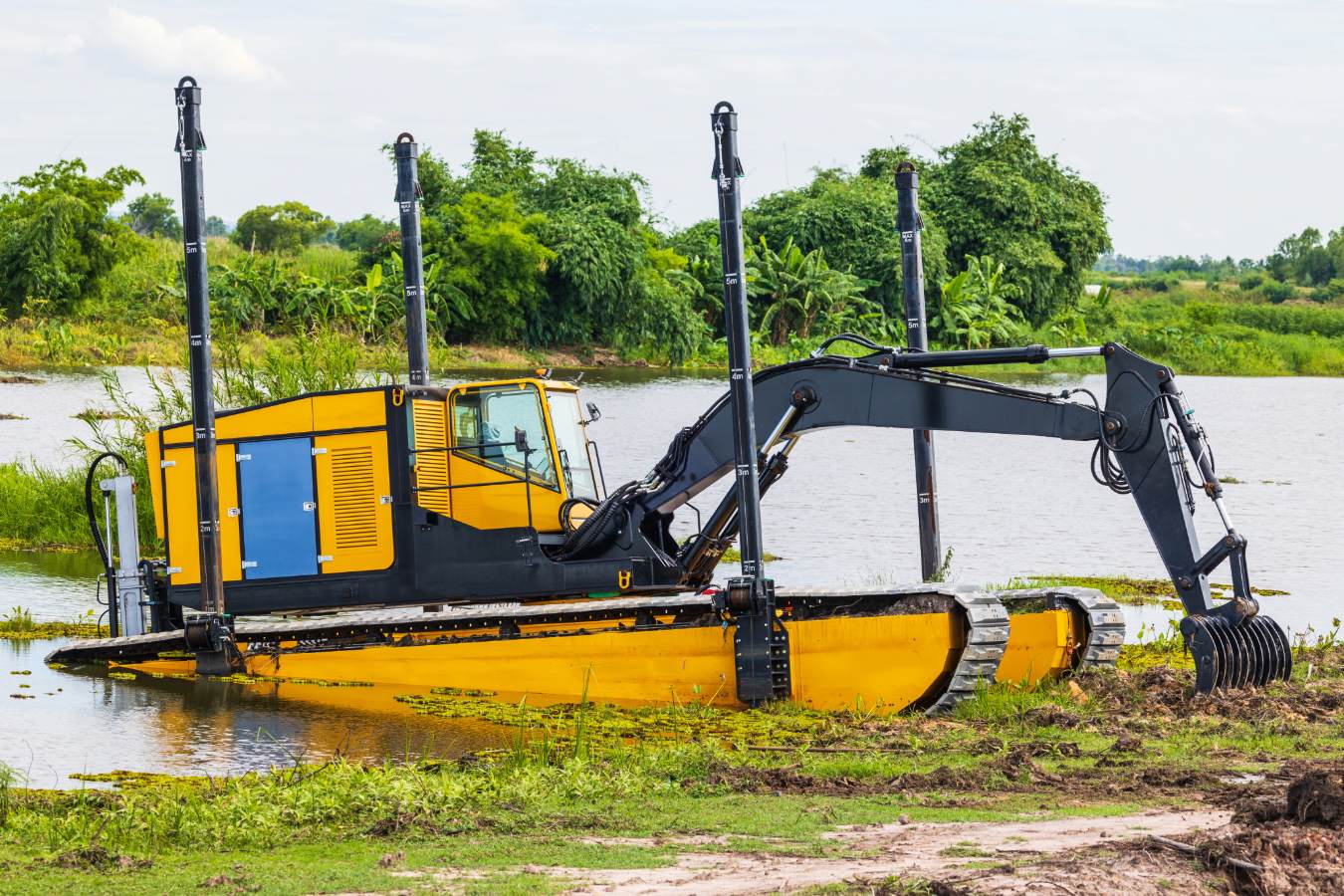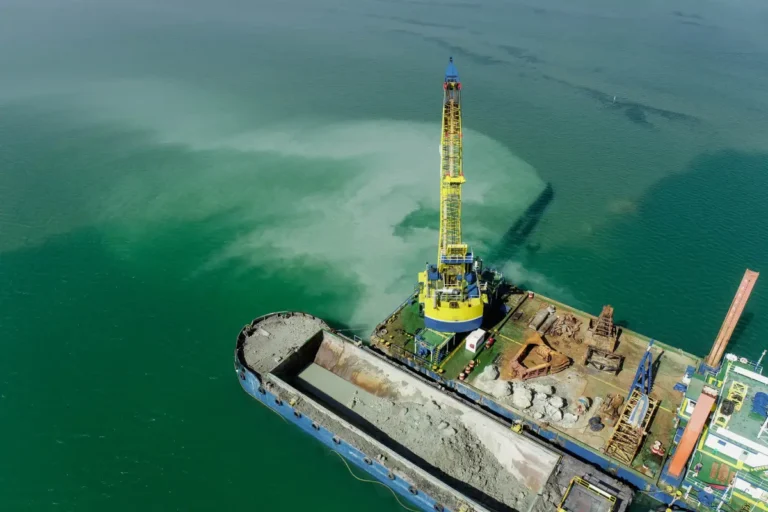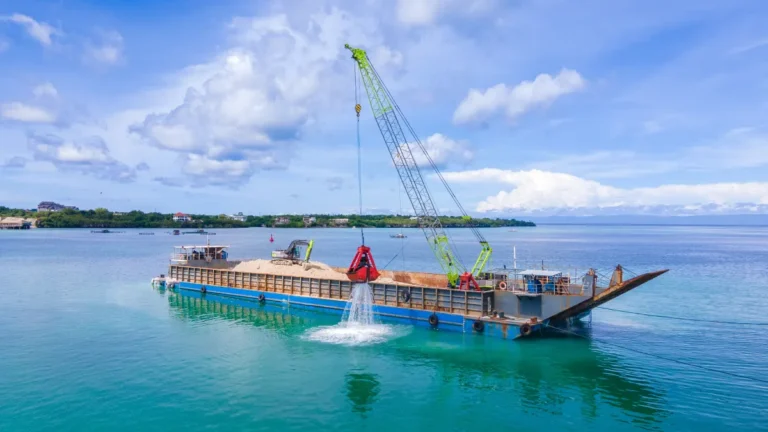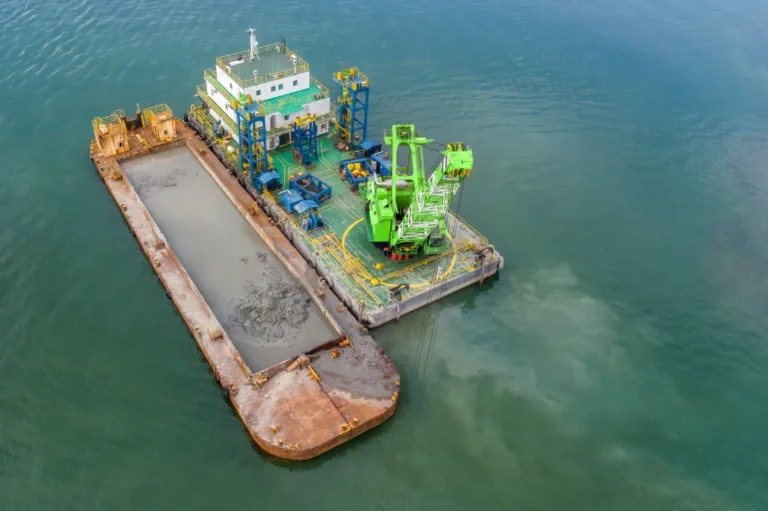Over time, lakes naturally accumulate sediment, organic debris, and pollutants that slowly degrade water quality and disrupt the delicate balance of aquatic ecosystems. This process, known as sedimentation, is accelerated by runoff, erosion, decaying vegetation, and human activity—resulting in shallower water, increased algae blooms, and a decline in fish and plant diversity. Left unchecked, these issues can render a lake unhealthy, unsightly, and even unusable for recreation or water management.
That’s where dredging a lake becomes essential. Lake dredging is a proven restoration method that involves removing built-up sediment and contaminants from the lakebed. By using specialized equipment—known as a dredge for lake environments—contractors can restore water depth, improve circulation, and eliminate nutrient-rich sludge that fuels harmful algae growth.
More than just a maintenance task, lake dredging plays a critical role in restoring ecological health. It supports native wildlife, improves water clarity, and helps stabilize the shoreline. Additionally, regular dredging enhances the lake’s ability to manage stormwater, prevent flooding, and remain resilient in the face of climate-related challenges. For communities, property owners, and conservation groups, dredging a lake is not just about aesthetics—it’s about safeguarding a vital natural resource for future generations.
What is Lake Dredging?
Lake dredging is the process of removing accumulated sediments, decaying organic matter, and debris from the bottom of a lake. Over time, natural and human-induced processes lead to sediment buildup that can severely impact water quality, reduce lake depth, and degrade the overall health of the ecosystem. Dredging a lake helps restore its natural depth, improve water flow, and create a cleaner, more sustainable aquatic environment.
Sediment accumulation in lakes occurs due to several factors. Runoff from surrounding land carries soil, sand, and nutrients into the water. Erosion along the shoreline, decaying plant material, and stormwater discharge further contribute to the buildup of unwanted material. Without intervention, this gradual infill can lead to a shallower lake, increased turbidity, algal blooms, and diminished habitat for fish and aquatic plants.
During a dredging project, a dredge for lake use is deployed—this equipment is designed to suction or excavate unwanted materials from the lakebed. The dredged material, which often includes silt, muck, trash, heavy metals, and nutrient-laden sediment, is then transported for proper disposal or repurposing.
The goal of dredging a lake isn’t just to remove sludge—it’s to restore balance. By eliminating the excess nutrients and contaminants, lake dredging improves water clarity, promotes healthier aquatic life, and extends the lake’s usable lifespan. It’s a vital step in long-term lake management and environmental stewardship.
Why Dredging a Lake is Necessary
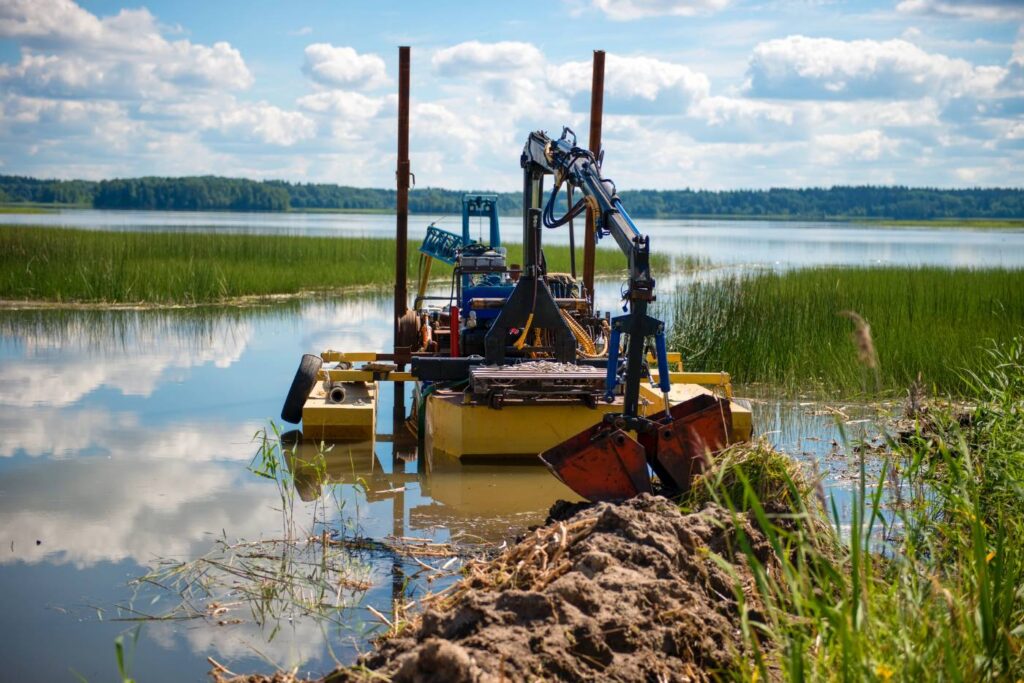
As lakes age, they undergo natural sedimentation—a gradual process where organic matter, soil, and debris accumulate on the lakebed. While this is a part of the natural lifecycle of a waterbody, the process can be accelerated by agricultural runoff, urban development, and erosion. Dredging a lake is a vital solution for reversing these effects and restoring the lake’s function and ecological health.
Reversing Sedimentation
One of the primary reasons for lake dredging is to combat sediment buildup. Over time, layers of silt and sludge reduce the depth of a lake, decreasing its water-holding capacity and disrupting aquatic life. Shallow waters heat up faster, creating an environment that’s hostile to many native species. Excessive sediment also smothers fish spawning areas and aquatic plant life. Dredging a lake helps restore depth and improve the physical structure of the ecosystem.
Improving Water Quality
A dredge for lake restoration is also used to remove nutrient-rich sediments that promote the growth of harmful algal blooms. Phosphorus and nitrogen trapped in the lakebed are key contributors to water quality issues. By removing these pollutants, dredging helps reduce algae outbreaks, improve water clarity, and restore the natural balance of the lake. Cleaner water also supports a more stable food chain, benefiting everything from microorganisms to larger fish species.
Additionally, lake dredging enhances dissolved oxygen levels. As deep areas are restored, water circulation improves, reducing the likelihood of low-oxygen zones (hypoxia) that threaten aquatic organisms.
Restoring Aquatic Habitats
Muck and organic debris not only lower water quality but also eliminate critical spawning and nesting grounds. Dredging a lake reclaims these lost habitats by clearing out excessive sludge and allowing native vegetation to reestablish. This creates a healthier, more diverse environment for fish, waterfowl, amphibians, and aquatic plants. In turn, this promotes stronger biodiversity and a more resilient lake ecosystem.
Flood Prevention and Water Flow
Another essential reason to dredge for lake maintenance is to prevent blockages that impair water movement. Inlets and outlets can become clogged with sediment, restricting natural flow and increasing the risk of flooding during storms or seasonal runoff. Lake dredging ensures that channels remain open and that the hydrologic balance of the lake is maintained, which is crucial for managing water levels and protecting nearby infrastructure and habitats.
Signs Your Lake Needs Dredging
While sediment accumulation and water quality decline can happen gradually, several clear warning signs indicate it may be time to consider dredging a lake. Identifying these issues early allows for timely intervention, helping to avoid more severe environmental and structural problems.
Murky or Discolored Water
One of the most visible signs your lake may require attention is consistently cloudy or brownish water. Suspended sediments and decaying organic matter contribute to murky conditions, reducing water clarity and limiting sunlight penetration. This negatively impacts aquatic plant life and the overall health of the ecosystem. Lake dredging removes the excess silt and particles that cause discoloration, thus restoring water clarity.
Excessive Weed or Algae Growth
An overgrowth of aquatic weeds or recurring algae blooms often signals nutrient overload, particularly from phosphorus and nitrogen trapped in the sediment. These conditions can choke out native species and reduce the usability of the lake for recreation. A dredge for lake restoration can remove nutrient-rich layers, reducing the fuel that drives unwanted vegetation and algae outbreaks.
Shallowing or Shrinking of Lake Area
If your lake seems smaller or shallower than it once was, sediment buildup may be the cause. Over time, the accumulation of silt can drastically reduce a lake’s depth and surface area. This not only affects aquatic habitats but also reduces the lake’s capacity to manage stormwater and runoff. Dredging a lake helps restore its original dimensions and functionality.
Fish Kills or Odor Issues
Unpleasant odors and fish die-offs are serious indicators of oxygen depletion and poor water quality. As sediment builds up and organic matter decays, oxygen levels can drop, leading to hypoxic or anoxic conditions. This suffocates fish and releases foul-smelling gases. Lake dredging improves circulation, removes decaying material, and restores oxygen balance, creating a healthier environment for aquatic life.
Accumulation of Muck or Sludge Near the Shoreline
If you notice thick, black muck or sludge accumulating near the edges of the lake, it’s a clear sign that sedimentation has reached problematic levels. This sludge not only limits recreational use but also accelerates the degradation of shoreline vegetation and habitats. Using a dredge for lake cleanup can effectively remove this buildup and restore natural shoreline conditions.
Methods and Equipment Used for Lake Dredging
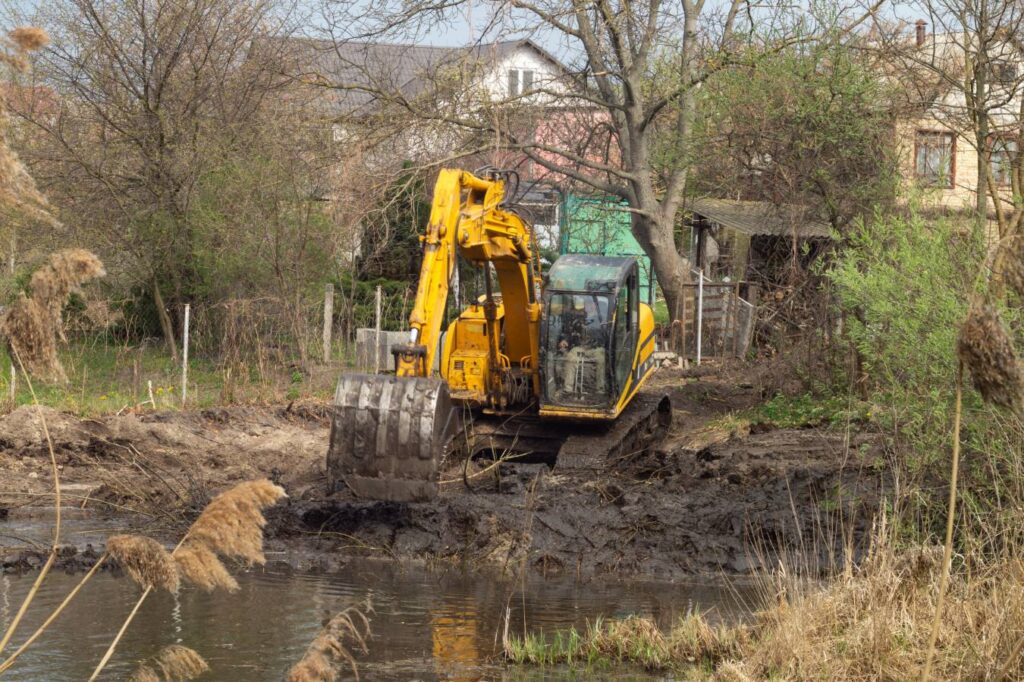
The process of dredging a lake involves specialized techniques and equipment designed to remove accumulated sediment while minimizing environmental disruption. The two primary methods—mechanical and hydraulic dredging—are selected based on factors such as lake size, sediment type, project goals, and site accessibility. Choosing the right approach is essential for ensuring an effective and sustainable outcome.
Mechanical Dredging
Mechanical lake dredging involves the physical excavation of sediment using heavy-duty machinery. This method is ideal for smaller lakes, shallow areas, or when precise control is needed near shorelines or infrastructure.
Common equipment used includes:
- Excavators and backhoes mounted on barges or working from the shoreline
- Clamshell buckets and draglines for scooping sediment from the lakebed
- Barges or trucks for transporting dredged material off-site
Mechanical dredging is often preferred when debris, trash, or compacted material must be removed. It’s also effective in colder climates where sediment may be frozen or when dredging must occur in dry conditions.
Hydraulic Dredging
Hydraulic dredging is a more efficient and less invasive method for dredging a lake, especially when working in deeper or larger water bodies. This process uses a dredge for lake environments equipped with suction systems to vacuum up sediment and water slurry, which is then pumped through pipelines to a designated containment or dewatering area.
Key components include:
- Cutterhead dredges, which break up compacted sediment before suction
- Plain suction dredges for softer, fine materials like silt or sand
- Pumps and floating pipelines to move slurry to disposal sites
This method allows for continuous dredging over larger areas with minimal disruption to aquatic habitats. It also supports precise depth control and reduces the risk of shoreline damage.
Choosing the Right Dredge for Lake Projects
Selecting the appropriate dredge for lake restoration depends on several factors:
- Scale of the project: Large lakes or deep basins benefit from hydraulic dredging, while smaller or irregularly shaped lakes may require mechanical methods.
- Sediment composition: Soft, fine materials are better suited for suction systems, while heavy or compacted sediments require mechanical excavation.
- Environmental sensitivity: Areas with protected wildlife or vegetation may necessitate low-impact equipment or seasonal timing.
- Site access: If there is limited access for large machinery or pipeline routing, the choice of dredging method may be constrained.
Environmental and Ecological Considerations

While dredging a lake is essential for restoration and water quality improvement, it must be carried out with careful consideration for the surrounding environment. Improper dredging can disrupt habitats, spread pollutants, or violate local and federal regulations. Following ecological best practices ensures that lake dredging supports long-term sustainability without causing unintended harm.
Permitting and Regulatory Requirements
Before initiating any lake dredging project, securing the appropriate permits is critical. Regulatory agencies, such as the U.S. Army Corps of Engineers, state environmental departments, and local water authorities, typically oversee dredging activities. These permits help ensure that the project complies with water quality standards, wetland protection laws, and sediment disposal guidelines.
Permitting processes often include environmental assessments, sediment testing, and public notification. In some cases, coordination with wildlife agencies may be required to assess the impact on fish, amphibians, or nesting birds. By aligning your project with legal requirements from the start, you can avoid delays and fines while maintaining a responsible approach to dredging a lake.
Minimizing Disruption to Existing Wildlife
Lakes are often home to diverse aquatic and terrestrial species that can be sensitive to changes in their environment. A well-planned dredge for lake restoration should aim to preserve, not disturb, these ecosystems. Dredging can temporarily displace fish, amphibians, and invertebrates, so efforts should be made to avoid active breeding or migration seasons.
Additionally, care should be taken to prevent excessive turbidity and sediment resuspension, which can degrade water quality and harm aquatic life. Limiting dredging to specific zones and timeframes helps reduce stress on sensitive species and supports natural recovery once the project is complete.
Silt Curtains, Seasonal Timing, and Best Practices
To further protect the environment during lake dredging, contractors often deploy silt curtains—floating barriers that contain disturbed sediments and prevent them from spreading across the lake. These curtains are especially important near sensitive habitats, such as spawning areas, wetlands, or drinking water intakes.
Seasonal timing is another crucial factor. Many projects are scheduled during colder months or dry seasons to minimize biological activity and reduce runoff. Following best practices, such as staging equipment away from the shoreline, avoiding fuel spills, and monitoring turbidity levels, also helps ensure that dredging a lake enhances the ecosystem without introducing new risks.
Long-Term Benefits of Dredging a Lake
Beyond short-term improvements in water clarity and depth, dredging a lake offers a wide range of long-lasting benefits that positively impact both the environment and surrounding communities. When done correctly, lake dredging becomes a smart investment in the future health and usability of a waterbody.
Extended Lifespan of the Waterbody
One of the most significant outcomes of lake dredging is the restoration and preservation of the lake’s natural depth and volume. By removing decades of accumulated sediment, a dredge for lake use helps prevent premature aging of the waterbody. This proactive measure slows eutrophication, reduces the need for future emergency interventions, and ensures that the lake remains functional and ecologically balanced for generations.
Increased Recreational Opportunities
Sediment buildup and weed overgrowth can limit access to areas used for boating, fishing, swimming, and paddling. By dredging a lake, access points are cleared, water depth is restored, and water quality is improved—making the lake more inviting and safer for recreational activities. Enhanced usability often leads to increased public engagement and community events centered around the lake.
Enhanced Aesthetics and Property Values
Shoreline muck, murky water, and algae blooms can negatively affect the visual appeal of a lake. Lake dredging improves the aesthetics by removing unsightly sludge and debris, leading to cleaner, clearer water and a more appealing shoreline. For homeowners, resorts, and municipalities, these visual improvements often translate into higher property values and greater tourism potential.
Improved Biodiversity and Ecosystem Resilience
Over time, sedimentation and pollution can choke out native species and destabilize food webs. Dredging a lake revitalizes aquatic habitats, allowing fish, amphibians, invertebrates, and aquatic plants to thrive. The improved water quality and restored habitat diversity contribute to a stronger, more resilient ecosystem—better equipped to adapt to environmental stressors such as drought, invasive species, or climate change.
Routine Maintenance vs. Restoration Dredging
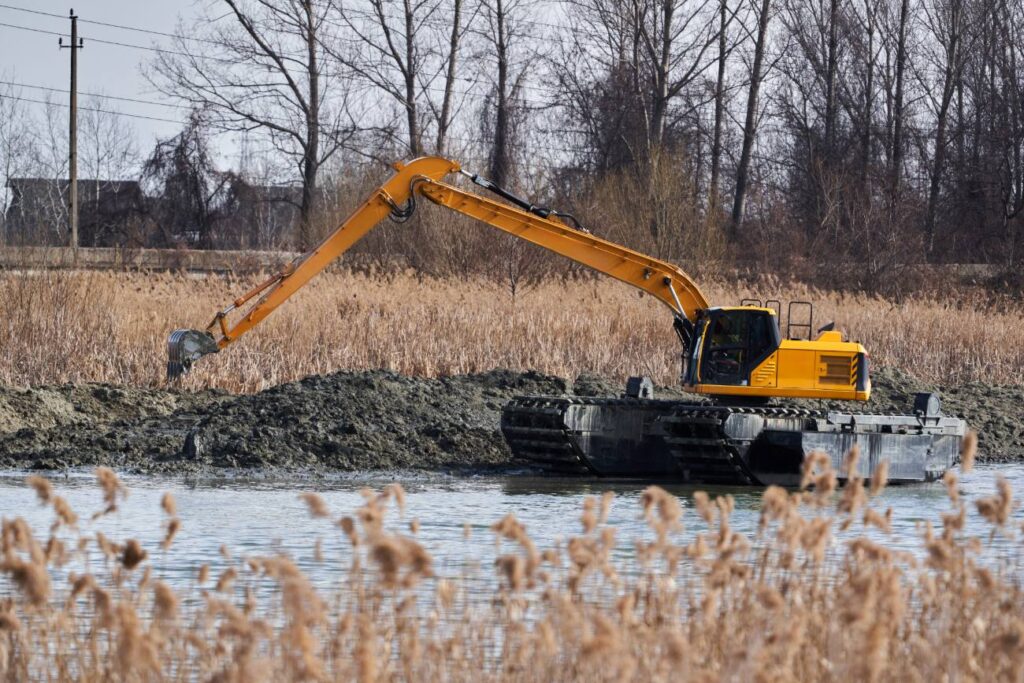
When it comes to dredging a lake, not all projects are created equal. While large-scale restoration dredging is sometimes necessary, routine maintenance dredging can often prevent the need for major, disruptive interventions. Understanding the difference—and the value of ongoing care—is essential for protecting the health and longevity of a waterbody.
Importance of Regular Inspections and Minor Dredging
Routine inspections allow lake managers and property owners to monitor sediment buildup, water quality, and vegetation changes over time. Early detection of problem areas—such as shallow zones, algal blooms, or muck accumulation—enables timely, small-scale lake dredging efforts before issues become widespread.
Minor dredging can be performed in targeted areas using compact equipment or a specialized dredge for lake maintenance. These smaller projects often require fewer permits, less disruption, and minimal downtime, making them ideal for keeping the lake in stable condition year-round.
Cost-Effectiveness of Proactive Management
Proactive sediment management through regular dredging is significantly more cost-effective than waiting until a lake reaches critical levels of degradation. Large restoration projects typically involve extensive permitting, environmental mitigation, and expensive dewatering or material disposal processes. In contrast, periodic maintenance reduces these costs and allows for better planning and budgeting.
Investing in preventive lake dredging minimizes the financial burden of emergency remediation and supports consistent ecosystem performance—especially for lakes that serve recreational, agricultural, or stormwater management functions.
Avoiding Major Restoration Expenses Through Early Intervention
Allowing sediment and pollutants to accumulate unchecked can lead to severe ecological imbalance, including oxygen depletion, fish kills, and total loss of recreational use. By dredging a lake at regular intervals, these costly and disruptive consequences can be avoided altogether. Early intervention preserves water depth, habitat integrity, and shoreline stability, helping to extend the life of the lake and reduce the need for large-scale restoration.
Whether managing a public lake or a private pond, consistent upkeep with a dredge for lake maintenance ensures smoother operations, healthier ecosystems, and lower long-term costs.
Challenges and Misconceptions
Despite the clear benefits of dredging a lake, many communities and stakeholders encounter roadblocks when planning or proposing a dredging project. From cost-related concerns to misunderstandings about environmental impact, these challenges can delay critical restoration efforts. Addressing these misconceptions head-on is essential for gaining support and moving projects forward effectively.
Cost Concerns and Funding Options
One of the most common concerns surrounding lake dredging is the perceived high cost. While large-scale projects can be expensive, the total investment often reflects years—or even decades—of deferred maintenance. It’s also important to consider the cost savings over time. Restored lakes typically require less chemical treatment, less invasive weed control, and fewer emergency interventions.
To help manage expenses, many municipalities and lake associations explore funding options such as grants, cost-sharing programs, or community assessments. In some cases, the long-term economic benefits—including increased tourism, recreation, and property values—outweigh the initial cost of dredging a lake.
Public Perception of Dredging’s Environmental Impact
Another challenge is the public perception that lake dredging may harm the environment. When poorly executed, dredging can disturb habitats or resuspend pollutants. However, modern dredging practices are guided by strict environmental regulations and best management practices that minimize ecological disruption.
Using the right dredge for lake applications, along with tools like silt curtains and seasonal planning, ensures that sediment removal is performed responsibly. Dredging a lake enhances ecological health by removing harmful nutrients, restoring habitats, and improving oxygenation.
Misunderstandings About Its Necessity and Long-Term Benefits
Some stakeholders may view dredging as a drastic or unnecessary measure, especially if the lake still appears usable on the surface. However, many of the issues that lake dredging addresses—like sediment accumulation, nutrient loading, and oxygen depletion—occur gradually and below the surface, making them easy to overlook until serious problems arise.
Educating the public and lakefront property owners about the long-term benefits of dredging a lake—such as improved biodiversity, water clarity, and resilience—helps shift the conversation from reactive problem-solving to proactive ecosystem management.
Conclusion
Dredging a lake is far more than a maintenance task—it’s a strategic investment in the health, usability, and longevity of a vital natural resource, from restoring water depth and improving water quality to enhancing biodiversity and preventing costly future repairs, lake dredging offers measurable benefits for ecosystems and communities alike. By understanding the signs of sediment buildup, selecting the right dredge for lake conditions, and approaching the process with environmental responsibility, stakeholders can ensure that their lakes remain clean, resilient, and functional for generations to come.


